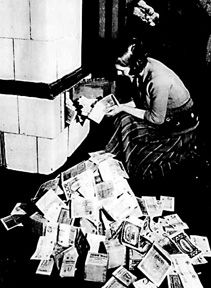Press Release
Signs of Crash in U.S. Debt Bubbles
July 2016
 2016 U.S. corporate bonds may go the way of 1923 German paper money. |
July 25, 2016 (EIRNS)—Ominous signs have appeared of a renewed collapse of high-yield ("junk") bank debt in the U.S. economy, potentially in the trillions. At the same time, industrial production and manufacturing output have stagnated or fallen for more than a year, while 215,000 jobs have been eliminated in the "energy" (oil and gas) sector, until a year ago the only real source of real capital investment.
The oil price, after its recovery of about one-third of its collapse since March, is again falling steadily (from $50 to $43/barrel, so far, for West Texas Intermediate crude), and this could turn into another steep drop. Despite continuous decline in U.S. crude oil production, gasoline demand keeps dropping. There is a renewed glut, now at a lower level, and refineries are now planning shutdowns earlier than the normal Labor Day point. Another 15,000 layoffs were announced this week by the big oilfield service firms; internationally, the loss is 385,000 jobs in this sector, reported the Wall Street Journal July 24.
Morgan Stanley, the oil expert "bank," reported July 22 that the gasoline market is "severely oversupplied internationally." "Refineries are the true consumer of crude oil.... Given the oversupply in the refined product markets, fading refinery margins, and economic run cuts, we expect crude oil demand to deteriorate further over the coming months."
But the oil sector extremely rapidly built up the biggest global debt bubble from 2004-2014, going from $4 trillion to $7 trillion indebtedness, with no increase in global revenue at $450 billion/year or so. In the U.S. the highest-risk parts of this debt are leveraged loans and junk bonds in the sector, together totaling about $1.4 trillion.
So far, only about $100 billion of this debt has defaulted, but the defaults are still increasing month to month despite the brutal cost-cutting represented by all that vanished employment. A renewed oil price plunge, will blow out a much larger chunk of that debt than has defaulted so far.
Meanwhile, the $1.4 trillion auto loan bubble, of which about $400 billion is now subprime and $150 billion "deep subprime," has been sailing along like Roadrunner off the cliff—until an accident today, involving a division of one of the world’s biggest banks. Santander Consumer USA Holdings, the biggest subprime auto lender, suddenly pulled back its second-quarter report for "revisions and new consultations with its accountants." Reminiscent of JPMorgan Chase upon realizing its huge "London Whale" losses. The Santander stock plunged 16%. Some 18% of all subprime auto loans defaulted in the past year, including 30% of all "deep subprime" loans, so other lenders to follow Santander Consumer are already being named.
